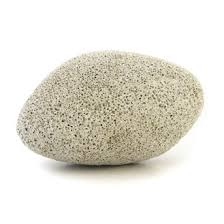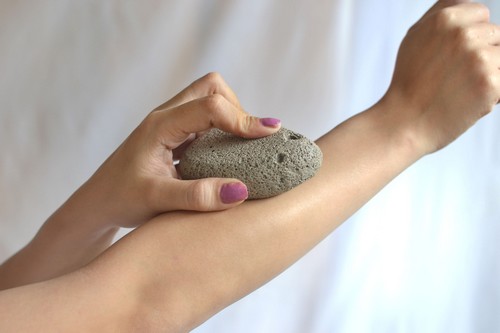Back in 2005 when I started my first blog and began dating Stoker, he had a run-in with a pumice stone. And I wrote a mildly decent post about it (linked, if you’re interested in reading the original), because why not?
It still cracks me up, that pumice stone incident. And I confess that I still find the improper use of pumice stones hilarious, especially when it involves Stoker, as an adorable 22-year-old.
Anyway, so apparently people really have a lot of questions about how to use these little chunks of sandpaper, because that post gets loads of regular traffic.
So, I’m revisiting the topic! And I’m also going to do everyone a solid and share new info, like the PROPER WAY TO USE A PUMICE STONE as well as give you the best clips of the old post here, because it makes a great format and I really like great things. Love the great things. Like, a lot.
Let’s get on with it. Let’s really dig into my in-depth tutorial on using a pumice stone! Here goes:
The other night Stoker scrubbed the inside of his elbow too vigorously with the pumice stone. He was taking a bath, reading his book on recording engineering, and he got this itch on his inner elbow. You know, the soft, pale part of your arm just below the bulge of round joint. I don’t know what he was thinking using a pumice stone there. But he did. He’s new to pumice stones, I suppose and didn’t realize that you should only use them on tough, calloused skin like the bottom of your feet and elbows.
- NEVER USE A PUMICE STONE ON SOFT SKIN.

An innocent-looking pumice stone. Should be fine on my skin, like all over my entire body, right? WRONG.
The itch flared up and the light blue, foot shaped pumice stone was resting on the edge of the bathtub, innocently minding its own business. Stoker’s eyes fell on its white flecked beauty and the idea struck him. He grabbed the light stone and scraped it lightly across the tender skin. It felt good. Deceivingly good. With a sigh, he brushed the skin with the pumice stone, effectively eliminating the itch.
2. WHEN CONFRONTED WITH A POWERFUL ITCH, EVEN WHEN A PUMICE STONE IS PRESENT, DO NOT USE THE PUMICE STONE TO SCRATCH SOFT TISSUE. At first, of course you might slide the pumice stone across the skin and find relief. OK, one soft stroke is fine. But as everyone knows, an itch doesn’t often go away with just one scratch. In order to avoid the inevitable scenario of too much pumice-stone-scratching, do not even engage in JUST ONE SCRATCH.
Later, the skin turned red. Raw. That’s when the whole story came spilling out: itch… pumice stone…I scrubbed it and it was great, at the time. But now it hurt. Like a burn. Poor kid. I truly felt bad for him, felt a little guilty for not warning him about the potency of a pumice stone. Though, when you think about it, I’m sure he knew. How could you not? I mean, it’s like sandpaper. No one rubs their skin with sandpaper, right?
3. PUMICE STONE USE SHOULD BE RESERVED FOR PORTIONS OF THE BODY WITH THICK, TOUGH CALLOUSES, LIKE THE HEEL, THE BALL-JOINT OF THE BIG TOE, OR, WELL YEAH, THAT’S ABOUT IT. And you know, just rub the pumice stone on the callous. It’s not rocket science (although, it occurs to me now, that maybe it is, and I’m just ignorant of the highly complicated process of pumice stone operation. Maybe I should do a Google search!).
So, to sum up, this is a bad idea, even for body hair removal [Note: this statement is not backed by any peer-reviewed studies]:

You want to do that to remove all your HIDEOUS BODY HAIR? Fine. Go for it. But we all know this body-hair removing use of pumice stones was started by pumice stone companies looking to have a new way to market their callous-removing tool.
To be safe, reserve the pumice stone for officially sanctioned (by the Pumice Stone Society of America) pumice stone activities. You don’t want to denude the top layer of your skin in some weird effort to rid yourself of body hair. Accept it! You’re a mammal. A beautiful animal that grew hair for a billion biological reasons, and mother nature doesn’t make mistakes (except for when she does, like accidentally).
If you really want to get rid of your arm hair (and stuff), consider a safer alternative, like burning it off with a curling iron, ah! Wait!
New use of curling irons!
Just a second . . . I’ve got Revlon on the phone now . . .




0 Comments